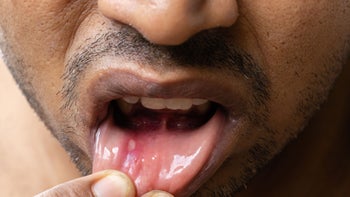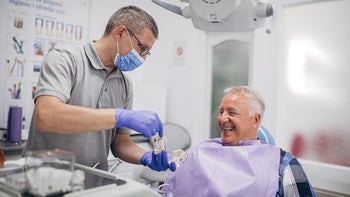
Health Debunked: Should I Use Fluoride-Free Toothpaste?
Key takeaways:
Fluoride is a naturally occurring mineral that’s used in dentistry.
Some claim that fluoride in toothpaste is harmful, but there is no evidence that this is true.
When shopping for dental products, look for ones that contain fluoride, as it is the best for tooth enamel health.
It can be alarming to hear a claim that a product you use every day, such as toothpaste, could be harmful to your health. Many rumors circulate the internet claiming that the fluoride in toothpaste is a toxic substance.
Here, we’ll separate fact from fiction to see if fluoride is safe to use as part of your dental hygiene routine.
What is fluoride?
Fluoride is a naturally occurring mineral found in water sources such as rivers, lakes, and oceans. Fluoride is also in present in small amounts in some food and beverages, including:
Brewed coffee
Canned shrimp
Raisins
Baked russet potatoes
Cooked rice
Pork chops
Fluoride is also in the water systems in most of the U.S. The Centers for Disease Control (CDC) reports that as of 2018, more than 207 million people (73% of Americans on community water systems) had access to fluoridated water.
How is fluoride used in dentistry?
Fluoride is a natural cavity fighter. The benefits of fluoride can be either systemic or topical. First, we’ll cover how it’s used systemically.
“Before your baby or adult teeth grow into the mouth, fluoride from food or water can help make the outer enamel layer of the tooth hard and strong, helping teeth naturally prevent cavities,” said Lauren Becker, DDS, a general dentist in New York City.
After the teeth come in, you can begin to use fluoride for its topical benefits. When you use toothpaste, mouthwash, or other fluoride dental products, you’re helping to rebuild weakened tooth enamel and prevent tooth decay.
Search and compare options
So how does this process work? Tooth enamel is made of hydroxyapatite, a mix of calcium and phosphate. Your saliva also contains calcium and phosphate and helps keep your tooth enamel strong. However, when you eat things like candy, cavity-causing bacteria feeds on the food and produces an acid that damages enamel. This is where fluoride comes in. When fluoride is in your enamel, it teams up with calcium and phosphate to become fluorapatite, a cavity-fighting tooth protectant.
“The fluorapatite is a lot more resistant to being broken down, and that’s why you should remember to use a fluoridated mouth rinse and toothpaste as part of your daily regimen to keep your teeth strong and healthy longer,” said Dr. Rhonda Kalasho, a double board-certified dentist at GLO Modern Dental in Hollywood.
Claim: Fluoride in toothpaste can cause several health problems
You might have heard that fluoride can cause bone disease, thyroid problems, and neurological problems, among other things. But is this true? And, if so, is the fluoride in your toothpaste a problem?
What does the science say?
In high doses during childhood, fluoride can cause dental fluorosis, a condition that causes white lines or flecks and white or brown stains on teeth. Excess fluoride intake can also cause:
Nausea and vomiting
Abdominal pain
Diarrhea
Periostitis (inflammation of the connective tissue surrounding bones)
Skeletal fluorosis (a very rare bone disease)
Death (rarely)
But when it comes to fluoride, the important thing to remember is that these issues only occur with really high doses — far beyond what you’ll find in toothpaste.
So how much fluoride is in toothpaste, and how much is dangerous? Well, most kinds of toothpaste contain 0.75 to 1 mg of fluoride per strip of paste that covers a toothbrush. The amount you actually swallow is even less. It’s estimated that:
Children under 5 consume 0.1 mg to 0.25 mg daily.
Children 6 to 12 consume 0.2 to 0.3 mg daily.
Adults consume 0.1 mg daily.
A toxic level is 32 to 64 mg elemental fluoride per kg of body weight. So there’s virtually no way that brushing your teeth with toothpaste could cause any of fluoride’s potential negative effects.
That being said, Sage Pollack, DMD, owner of Dentistry of Colorado, recommends keeping fluoride toothpaste out of the reach of small children so they don’t accidentally eat an entire tube.
What do the experts say?
Expert organizations across the board support the use of fluoride toothpastes:
The American Dental Association (ADA) recommends brushing twice a day with fluoride toothpaste. Specifically, the ADA says to look for an option with the ADA Seal of Acceptance.
The Centers for Disease Control and Prevention (CDC) recommends fluoride to prevent tooth decay.
The National Institute of Dental and Craniofacial Research (NIDC), part of the National Institute of Health, recommends brushing twice a day with fluoride toothpaste.
When it comes to fluoride toothpaste for children, expert opinion is as follows:
Children under age 3: The ADA and American Academy of Pediatrics (AAP) recommend an amount the size of a grain of rice as soon as they have their first tooth. The NIDC, however, cautions that children under age 2 should avoid it.
Children ages 3 to 6: The ADA and the AAP recommend a pea-sized amount. The CDC also recommends a pea-sized amount for children under age 6, followed by a thorough rinse.
Are there any alternatives to fluoride?
Fluoride is the gold standard for preventing cavities, strengthening teeth, and fighting bacteria in the mouth. “Unless a doctor recommends otherwise, people of all ages should use toothpaste with fluoride to clean and protect their oral health,” said Dr. Jeffrey Sulitzer, DMD and chief clinical officer of SmileDirectClub.
But if you’re still not sure if you want to use fluoride toothpaste, you might wonder what alternatives are out there. Here’s what we know about two promising ingredients and two that are popular but lack scientific evidence:
Nano-hydroxyapatite (n-HA): N-HA might be a reasonable replacement, according to Dr. Casey Lau, the Chief Dental Officer of Elims in Los Angeles, CA. “There is only one other ingredient that competes with fluoride, and that is n-HA, a mineral and natural alternative to fluoride, that can actually add back what time and acid-producing foods have taken away,” he said. Lau considers it a good solution for people who are wary of fluoride. “And clinical and scientific studies prove that at certain concentrations, n-HA is just as effective as fluoride, which is actually a game-changer.”
Casein phosphopeptides-amorphous calcium phosphate (CPP-ACP): One study on artificial teeth found that, in addition to n-HA, CPP-ACP, an ingredient found in milk, may work similarly to fluoride in terms of remineralizing teeth.
Charcoal: There’s no convincing evidence that charcoal whitens or protects teeth. In fact, it might actually wear down tooth enamel.
Aloe vera: There is some evidence that aloe vera gel has antibacterial properties that benefit dental health, but the studies took place in labs, so it’s hard to know how these benefits would translate to humans.
How else can I keep my teeth strong?
There are tips to improve dental health that go beyond toothpaste. They include:
Avoiding foods and drinks high in sugar
Seeing your dentist regularly
Flossing daily
Avoiding oral piercings
The bottom line
You shouldn’t switch to fluoride-free toothpaste. While consuming too much fluoride can be problematic, using the recommended amount to brush your teeth is not only safe but also the best way to keep your teeth enamel strong and healthy.
Why trust our experts?



References
Agency for Toxic Substances and Disease Registry. (2003). Health effects. Toxicological Profile for Fluorides, Hydrogen Fluoride, and Fluorine.
Amaechi, B. T., et al. (2019). Comparative efficacy of a hydroxyapatite and a fluoride toothpaste for prevention and remineralization of dental caries in children. BDJ Open.
American Dental Association. (n.d.). Brushing and beyond: Key oral health tips for anyone with a smile.
American Dental Association. (n.d.). Fluoridation FAQs.
American Dental Association. (2023). Fluoride: Topical and systemic supplements.
American Dental Association. (n.d.). Fluorosis.
Brooks, J. K., et al. (2017). Charcoal and charcoal-based dentifrices: A literature review. The Journal of the American Dental Association.
Centers for Disease Control and Prevention. (2019). About fluoride.
Centers for Disease Control and Prevention. (2023). Water fluoridation data & statistics.
Clark, M. B. (2020). All about fluoride: Updated clinical report covers caries prevention in primary care. American Academy of Pediatrics.
George, D., et al. (2009). Comparative evaluation of the antimicrobial efficacy of aloe vera tooth gel and two popular commercial toothpastes: An in vitro study. General Dentistry.
Kasemkhun, P., et al. (2021). The efficacy of non-fluoridated toothpastes on artificial enamel caries in primary teeth: an in vitro study. Journal of International Society of Preventive & Community Dentistry.
National Institute of Dental and Craniofacial Research. (2019). Fluoride & dental health. National Institutes of Health.
Office of Dietary Supplements. (2023). Fluoride: Fact sheet for health professionals. National Institutes of Health
Science Direct. (n.d.). Tooth enamel.
Walsh, T., et al. (2019). Fluoride toothpastes of different concentrations for preventing dental caries. Cochrane Database of Systematic Reviews.

























